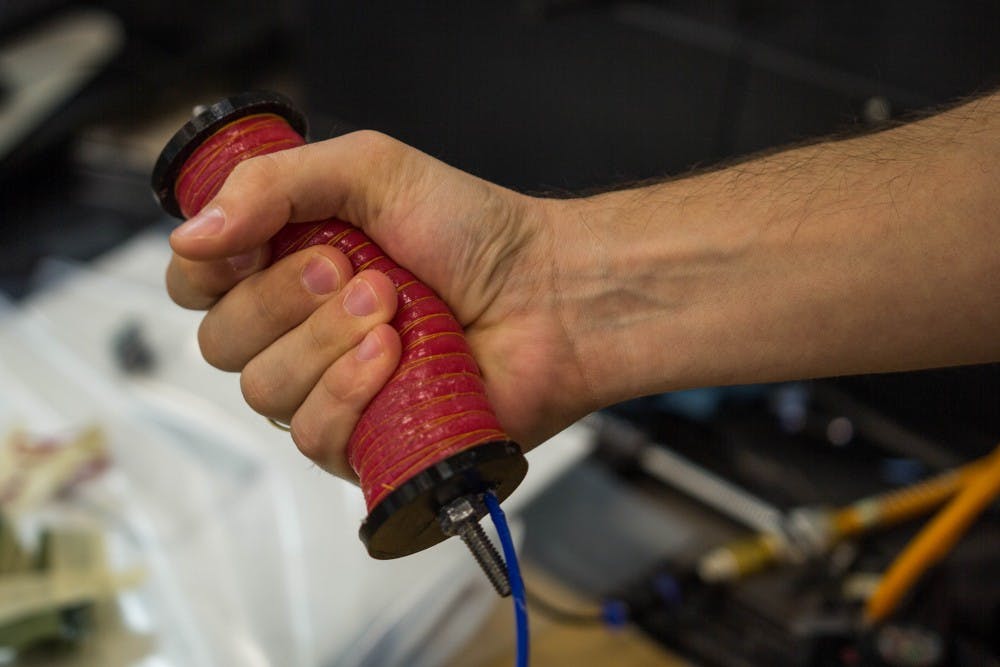ASU researchers are enhancing the development of a new neuromuscular rehabilitative device with the use of soft robotics.
Four ASU researchers have created a unique, soft, silicone-based robotic device that can be used in rehabilitating hand motions for individuals who have impaired motor skills.
The impairments they are addressing with the devices involves loss of full use of the hands due to a neurological condition, such as a stroke.
Panagiotis Polygerinos, an assistant professor in the Ira A. Fulton Schools of Engineering is the lead professor on the project.
“We got inspired by seeing all of those mechanisms that are currently used in rehabilitation settings to strengthen motor skills, such as grasping, for individuals that have impairments,” Polygerinos said.
According to their research, the soft robotic device can help impaired hand functions by encouraging the central nervous system to relearn and reshape the lost synapses in the brain.
The haptic device was created using 3D printing, polymer molding and different casting techniques, which helps keep the cost of the device low and its performance effectiveness high.
The soft device is linked to an open-loop system that increases pressure when used and is linked with a closed-loop system that allows pressure regulation.
Their new device uses soft silicone, which is a cost effective material that allows the user to overcome these past stiffness issues and receive a new, better therapy session.
“These problems that have not been addressed gave us the inspiration to explore through soft robotics which is a new subfield in robotics that looks into nature for inspiration for how motions can be achieved in a more complex, but then at the same time more compliant, way,” Polygerinos said.
Another research project in soft robotics by ASU researchers.
In the past, the team of researchers have noticed that users of other hand-strengthening devices to combat weakened grasping abilities are asked to do repetitive motions in therapy.
These motions include squeezing, opening and closing different types of objects in their hands and more, but Polygerinos said that this type of therapy can be more limiting compared to their device.
He said that, from what the team has observed, devices already developed are stiff and rigid.
"They don't allow the user to do a therapy session that will allow the device to be tailored or accustomed to the user needs," Polygerinos said.
Simon Holzapfel, a clinical assistant professor at ASU’s College of Health Solutions, said that soft robotics can help patients because during the rehabilitation process, muscles will break down and rebuild in place of old, damaged muscles or build on top of the damaged ones.
“There is some research that has shown (soft robotics) can actually help in the rehabilitation of their own movement," Holzapfel said.
The team is still in the testing stages of the project but wants to make sure they addressed this issue.
"We gave the prototype device to a number of healthy participants and asked them, without them knowing what settings we had set the pressure in our devise to, to guess what is the stiffness compared to other devices," Polygerinos said.
Qiushi Fu, a research assistant professor in the school of Biological and Health Systems Engineering, helped design the experiment.
“The overall goal of the project was to create a ... device that is capable of different levels of stiffness, so that patients with any hand impairment or hand control will be able to preform exercise on that for rehabilitation,” Fu said.
Frederick Sebastian, who graduated from ASU in 2018, was the primary investigator on the project and said the idea behind the device was to repair the neurons in the brain through gripping exercises.
"The goal was to regain some of the synapses that you have lost, some of the functionality, and usually that's through exercise," he said. “We tried to develop a device that could help them get some of the ability back at home or in a clinical setting."
The research group hopes to begin testing the device with stroke patients as soon as they find a student to lead testing on the project.
Reach the reporter at karichm1@asu.edu and follow @Kellyarichmond3 on Twitter.
Like The State Press on Facebook and follow @statepress on Twitter.




